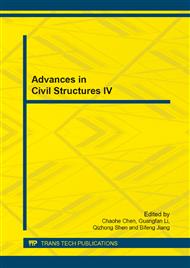p.1357
p.1361
p.1366
p.1370
p.1374
p.1379
p.1396
p.1400
p.1405
Chloride Penetration and Aging Behaviors of Surface Protected Concrete with Silicone Material
Abstract:
Concrete structures are exposed to severe environment that may cause rapid decay, shortening their service life and raising maintenance and repair costs. Chloride ions will lead to the depassivation of reinforcing steel bars in concrete which is one of the most serious problems to the durability of concrete. Then, the prescriptive methodology is not a guarantee to obtain the desired service lives of 50 or 100 years. Surface treatment is commonly used to improve the resistance of concrete to chloride erosion. Using the silicone materials to an immersion treatment can effectively block the invasion of harmful substances,the resistance of concrete to chloride penetration with surface protection with silicone materials was evaluated. The results showed silicone can improve the resistance to chloride penetration than the non-protected concretes. As a kind of polymer materials, the aging behaviors of silane is a matter of urgent concern. Hence, the aging behavior of silane coated concrete is evaluated by the test of water absorption after 1000h xenon lamp aging, which exhibits excellent anti-aging performance of silane.
Info:
Periodical:
Pages:
1374-1378
Citation:
Online since:
July 2014
Authors:
Keywords:
Price:
Сopyright:
© 2014 Trans Tech Publications Ltd. All Rights Reserved
Share:
Citation:


